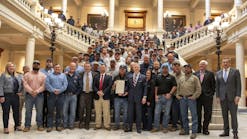When it comes to wildfires the experts are saying, “Abnormal is the new normal.” According to the National Interagency Fire Center, from Jan. 1 to Aug. 16, 2019, there were 30,000 fires and 3,667,237 acres were burned. The Department of Interior, reports that 90% of wildland fires are caused by people, with the remaining 10% started by lighting or lava. Putting it closer to home, fires caused by power lines have been among the top three major causes of California wildfires in recent years.
How to prevent powerline-caused fires has led to some serious discussions among regulators and utilities. There are two basic mitigation strategies on the table: Don’t let them get started and find them while they are small enough to quickly extinguish. These efforts range from the simple to the complicated in their scope and that is where things are getting interesting in the technological world.
Early Detection
The first early warning systems were the fire lookout towers, but there is a new technological twist to these venerable towers. It’s an early warning system using infrared camera/high-definition camera networks placed like towers throughout critical areas. These cameras can operate day and night and have spotted blazes early enough to allow firefighters to stop them before spreading. Forbes reported San Diego Gas & Electric (SDG&E) is using a network of these cameras combined with AI to predict wildfires.
The University of California Berkeley has developed an interesting early warning system called FUEGO (Fire Urgency Estimator in Geosynchronous Orbit) It is a system using satellites with infrared sensors and other devices that can monitor the entire western United States every few minutes looking for fires as they begin and spread.
Another sophisticated early warning system comes from the University of California San Diego. It is called WIFIRE, which uses remote sensors, weather stations, high definition satellite imagining and artificial intelligence to predict a wildfire’s path in real time. These devices feed the big data into sophisticated computer models, which use AI to predict where and when wildfires will spread.
Don’t Let It Start
There is another method also being explored — preventing the fire before is starts. Without going into a lot of technical details here, utilities and manufacturers are exploring many schemes to eliminate the sparking source. One promising approach is the broken conductor detection and protection scheme. There are also reclosure blocking and using fuses with fast curves. Sensitive ground fault protection and high-speed protection relays with synchrophasor (phasor measurement units) have also been suggested. They all work on the simple principle that if a conductor is deenergized fast enough, it stops the fire before it has a chance to start.
Voluntary Outages
One of the most controversial of the prevention schemes is the voluntarily cutting off the electrical power to selected circuits. It is called the “public safety power shutoff” authority or PSPS for short. Essentially the utility de-energizes the transmission or distribution lines running through areas where the conditions (drought, heat, wind, etc.) have an extremely high probability (are perfect) for generating wildfires.
This idea came about after the deadly 2007 wildfire season. SDG&E asked the California Public Utilities Commission (CPUC) for voluntary outage authority. It was approved. After the disastrous 2017 California wildfire season it was expanded to include Pacific Gas & Electric (PG&E) and Southern California Edison (SCE), which produced a lot of controversy. Customers didn’t want wildfires, but extended power outages weren’t acceptable either.
The CPUC directed the utilities to set up a program to forecast outages as far ahead of time as possible. It also developed some guidelines and a fire threat map of California to help the utilities with this alerting system. With each fire season, it seemed the fire danger area expanded and more of the population was impacted.
The PSPS usage debate increased after the horrendous 2018 fire season, but the utilities must keep their customers safe. So, SDG&E, PG&E, SDG&E and other utilities announced they were enlarging the area of the PSPS program. Expanding the use of the PSPS program impacted more customers with more outages.
Who Is Ready
The basic issue remains. How does the business and residential customer deal with curtailments that can last for four or five days? When you think about it, more outages for such long durations can be devastating, but there are some off-the-shelf technologies ideally suited for this dire situation. There is a group in the power delivery system known as the “Prosumer” and they may have the best answer for the problem.
These customers both produce and consume electricity by taking advantage of several technologies available to everyone. Prosumers have installed rooftop solar panels, fuel cells, and microturbines. These devices have allowed them to supply their own electrical needs and sell the excess to the grid. It has established the two-way flow of power and put electricity generation sources behind the meter on the distribution system. This is essential for customers scrambling to figure out how to live with these outages. Officially these devices fall under the banner of distributed energy resource (DER) technologies.
DER includes a lot of components that are cutting-edge technologies, but let’s look at the microgrid. Simply put, microgrids are composed of a power generation source, a monitoring system, and a control scheme. Microgrids can be used singularly or aggregated for more coverage. They are not really a new technology, but the public’s awareness spiked with Superstorm Sandy when the lights went out on 8.5 million people.
People noticed there were isolated islands of electricity shining in the blackout. After the recovery, there were many questions about how that happened, and the simple answer was the microgrid. As more and more utilities embrace the concept of the PSPS, many experts feel it will have the same effect. It is easy to imagine the uproar that will be produced when one customer has electricity for the week and the rest of the neighborhood is blacked out.
Gary Rackliffe, ABB’s vice president, Smart Grids and Grid Modernization discussed the California PSPS method with T&D World. He said, “One of the biggest advantages of the grid is its reliability and its low cost of power. When PSPS events compromise that reliability, investments by residential customers to sustain power during PSPS events may enable them to become more independent.”
Behind-the-Meter Solution
That appears to be spot on with all the interest coming from the customers’ side of the meter today. According to the Solar Energy Industries Association, about 315,000 residential customers in the U.S. added solar panels in 2018. 2019 appears to also be on track for significant growth. In addition, California’s Building Standards Commission now requires all new residential construction to include rooftop solar panels, which begins in 2020. It is estimated that between 80,000 and 100,000 single family homes are built each year, which will be quite a boost to California’s residential solar rooftop market.
For the residential and commercial customer, Tesla sells and leases solar with storage packages. The systems utilize Tesla’s Powerwall technology that can be combined with solar rooftop systems such as Tesla’s solar roof system. This is a glass roofing tile that incorporates a solar technology in each tile, making the building’s entire roof a solar collector. Another company, Sunrun, offers solar panels with their “brightbox” battery systems powered by LG Chem battery technology. The company offers the equipment, the installation and a leasing or purchase agreement, so the customer has lots of options.
Schneider Electric and Scale Microgrid Solutions announced a partnership to produce a sustainable on-site energy solution called Rapid Response Modular Microgrid (R2M2). This is a scalable microgrid for commercial and industrial (C&I) customers. R2M2 allows the customer to go to island mode in the event of a blackout using off the shelf distribution generation technologies and lithium-ion batteries.
Another C&I-focused supplier is Bloom Energy whose microgrids are based on fuel cell technology. Bloom Energy’s fuel cell uses natural gas in an electrochemical reaction to generate electricity. They can be operated in parallel with the grid (grid connected) or independently (grid-islanded) as needed.
PSPS operations are causing residential, commercial and industrial customers the same challenge. They have to be able to survive extended power shut offs without significant consequences to their lives and businesses. Microgrids are off-the-shelf technology that has been proven in field. Manufacturers like ABB, Eaton, GE, Mitsubishi, Siemens and others are combining DER systems with energy storage technology, which is exactly what these devices need.
With storage, the DERs have a tremendous capacity for addressing the California PSPS customer worries, but it is more than a California issue. Wildfires are a global concern and the PSPS approach is being studied worldwide. It could be that the customer’s DER and energy storage is going to be a transformational force on the grid.


